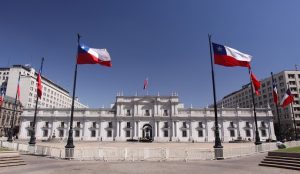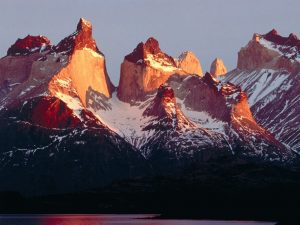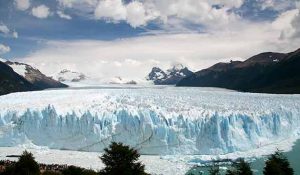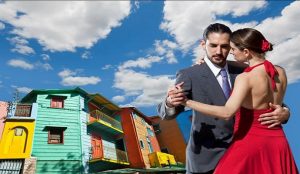 Print Itinerary
Print Itinerary
Inclusions
- All Airport / Hotel Transfers
- Accommodation with breakfast
- Visit some of the best known cities in the Argentinean and the Chilean Patagonia.
- And much more…
Note: Extra departures available with a minimum of 2 participants (higher price may apply). Maximum group size of 16 participants.
Day 1 – BUENOS AIRES
Upon arrival in Buenos Aires transfer from the airport to the hotel.
Day 2 – BUENOS AIRES (B)
After breakfast you will visit the most important sites during a city tour. You will drive to the Plaza de Mayo, the Casa Rosada, the pink house, seat of the government, the Cabildo (town hall) and the Metropolitan Cathedral, home of the Archbishop of Buenos Aires. The tour goes onto the district of San Telmo.
Until 1888 this part of the city was a river port, today San Telmo is one of the most modern and desired places to live in Buenos Aires. The worker district La Boca is famous for its colorful tin-houses and its history as a living district of the Italian seamen and dock workers in the 19th century. The Barrio Norte called Recoleta is the quarter of the rich of Buenos Aires. In the cemetery of Recoleta one will find the grave of Eva Duarte who became famous as Evita Perón. Continue along the widest avenue in the world, the Avenida 9 de Julio, and continue to the Plaza Lavalle with the Federal Court of Justice and the Teatro Colón, to Palermo with its parks and gardens and back to the hotel.
Afternoon free at leisure – optional tours can be booked with our office.
Optional: Half Day Tigre Tour. From your hotel we will drive along the Northern residential districts of the city, arriving at San Isidro, a colonial and aristocratic area. You will see the mansions and houses in front of the River Plate. You will continue driving to Tigre, a charming area near Buenos Aires city where a great number of summer residences, yacht clubs and rowing clubs attract the weekend activity of many “porteños”. The Tigre Delta with its rivers, streams and numerous green islands is one of the most attractive areas for visitors. The continuous sediment of the Paraná River, which gives the river and estuary their particular brownish-red color, forms the Delta islands. Enjoy a boat excursion (1 hour) along the innumerable channels of the Paraná-Delta to see some of the hundreds of islands covered with luxuriant vegetation. Drive back to the city to your hotel via the Panamericana Highway.
Optional:Visit San Telmo market. From your hotel we will take you to San Telmo, which is no doubt the best kept historical neighborhood and oldest district of Buenos Aires. Here one has time to stroll around Plaza Dorrego, where each Sunday an antique market takes place. Tango couples are dancing on the street. Cafes invite you to sit on their terraces and to relax by enjoying the lovely scenery. Another attraction are the numerous souvenir shops, where one might find the right souvenir. After the visit, return to the hotel.
Optional:Dinner and Tango Show at the Restaurant Viejo Almacen.
Day 3 – BUENOS AIRES – USHUAIA (B)
Transfer to the airport, to board your flights to Ushuaia (not included). Upon arrival in Ushuaia meet and transfer to your hotel. Day at leisure.
Day 4 – USHUAIA (B)
In the morning you will go on a half day tour to the Tierra del Fuego National Park, where you will get the impression that time goes slower than anywhere else.
The long stormy winters and the width of the sky form a very simple and modest way of living.
The National Park is crossed by many rivers which flow into the Beagle Channel.
Drive through the park to enjoy the landscape and have a little stroll.
In the afternoon the following optional tour can be booked with our office:
Optional: Catamaran tour on the Beagle Channel
The Beagle Channel has its name due to the expedition made by Charles Darwin. You will pass through the Casco Island where many nests from seabirds and sea lions can be seen then onto the Island Los Lobos to see the sea lions.
Day 5 – USHUAIA – CALAFATE (B)
Transfer to the airport and flight to El Calafate (not included). Pick up at the airport by our local guide and transfer to the hotel.
The afternoon is at leisure, and optional tours can be booked with our office:
Optional:
Half day Glaciarium Museum – The Glaciarum Museum is the first museum in South America dedicated to the glaciers and Patagonia ice. It has a privileged location, situated close to El Calafate town (20 minutes drive) on the way to Los Glaciares National Park.
The whole complex is a last generation interpretation centre which will offer to the visitors an interactive exhibition with the aim to learn about the glaciers.
It`s an interactive museum with theme rooms, exhibitions showing recent investigations, scenic & lighting effects,
it also counts with a permanent exhibition focused on global climate changes and the environmental problems on earth.
Day 6 – CALAFATE – PERITO MORENO (B)
Today guests will go on a full day tour to the Perito Moreno Glacier. After a drive through the National Park Los Glaciares one will arrive all of a sudden at a forest full of colours, before one sees – equally unexpected – the glacier Perito Moreno. This is one of the few glaciers that is still growing. Every 4 to 5 years it covers the gap between the mainland and itself and grows into the Lago Argentino. Eventually the ice cannot resist the enormous pressure of the water and crashes with a frightening noise. One can watch this glacier spectacle every day when single ice blocks fall into the lake. Considering that the glacier is 5 km long and 70 m high one can imagine the noise this makes. Here we will have 2 hours to experience the glacier before driving back to Calafate
Day 7 – CALAFATE – PUERTO NATALES (B)
In the morning transfer to the bus terminal. From here guests will travel via the public bus to Puerto Natales. Pick up at the bus terminal and transfer to the hotel.
Day 8 – PUERTO NATALES–TORRES DEL PAINE NATIONAL PARK – PUERTO NATALES (B)
After breakfast drive to the Torres del Paine National Park. You will be able to appreciate the most spectacular worldwide reserve at the end of the world, 150km northwest ofPuerto Natales. In this protected area you will find a fertile combination of lakes, lagoons, waterfalls, glaciers, hills and peaks. Inside the area, the road is surrounded with dozens of lagoon, contrasting with hills and snow-capped mountains. You will visit among other things Milodon Cave and the Salto Grande waterfall.
In the late afternoon drive back to the hotel.
Day 9 – PUERTO NATALES– PUNTA ARENAS–SANTIAGO (B)
Early morning transfer to the bus terminal in Puerto Natales and transfer by public bus (4h) to the city of Punta Arenas.
Upon arrival at the public bus station, you will be welcomed by your local guide for a city tour through Punta Arenas, which was the first permanent settlement in Austral Patagonia. The settlement began on the 18th of December 1848 as a small colony, in a couple of years it developed to be the most important cultural, commercial, and cattle raising centre of Patagonia. You proceed on a tour through the tidy laid out avenues and squares which host more than thirty monuments. Proceed to Cerro La Cruz, from where you can enjoy a fantastic panoramic view of the city and the Strait of Magellan.
Afterwards continue to Punta Arenas airport for your flight to Santiago de Chile (not included). Upon arrival pick-up and transfer to the hotel.
Day 10 – SANTIAGO DE CHILE (B)
Santiago de Chile is a city of contrasts with the remains of its colonial past to the ultramodern, high-rise buildings of the financial centre; Chile’s capital city will surprise you.
At the beginning of the city tour you will see San Francisco church, which was built between 1572 and 1618. You will pass through the Barrio Paris & Londres which is characterized by its European architectural style and its’ narrow cobbled streets.
Then you will visit the area of the Club Hípico, one of the most beautiful horseracing tracks in South America, privileged by its architecture of the late 19th century.
Continuing your tour towards the Barrio Concha y Toro, you will immediately notice that the constructions of the buildings here are very similar to those in the Barrio Paris y London. While walking through the main street you will recover vestiges of the aristocratic past of the capital. In 1989 this district was declared as “Zona Tipica” (Typical zone). You will be impressed by the gothic, neo-colonial and Bauhaus constructions.
After that you will visit the Plaza de Armas and see the cathedral. Just around the corner, you will find the main post office, the National History museum and the town hall of Santiago. From here you head along the famous Alameda, Santiago’s colorful main avenue, towards the heart of the city, seeing the “Palacio de la Moneda” (seat of government), various monuments and public buildings on the way.
Continue the tour by driving up to the top of the San Cristóbal Hill. From one of the hill’s view points, you will have the finest views of Santiago and the Andes Mountains. To round off the tour, you will pass through the modern residential areas of the city with their daring architecture and, finally, the bustling Providencia shopping zone.
Day 11 – SANTIAGO DE CHILE (B)
Transfer to the airport for flight back home.
End of our services
Food Code = B – Breakfast, L – Lunch, D – Dinner.
LHSTBUE002*Please note, prices based on twin share, per person, low season, 3 star rates. Optional tours not included and are at extra cost. The itinerary & pricing can change at any time due to availability & activities. Please check our website for full terms and conditions*
More on the visited countries:
Argentina- – the second biggest state of South America, has a surface of 2.8 million square kilometres. The country has 33 million inhabitants and nearly half of them live in the surroundings of Buenos Aires, one of the most cosmopolitan cities in the world. Argentina is a fascinating land of contrasts where the exceptional is almost commonplace. It’s home to an abundant wildlife, enjoys a unique culture, and delights in an astonishing variety of landscapes from tropical rain forest in the north to the remote vastness of the Antarctic in the south. Three big landscapes form the country: the Andes in the west, the northern and western flatland as well as the wide plains of Patagonia in the south. The country that is stretched in length has three climatic zones: tropic in the north, moderate in the centre and polar in the extreme South. The native Indian people live in the north-western Andean region and in the north-east province of Misiones. The rest of the population is mainly composed of European immigrants. The official language is Spanish, but in larger towns English is also quite common.
Chile – squeezed between the Andes and the Pacific, with a maximum width of 44 kilometres, this country is a unique thin 4,300 kilometre long coastal stripe. For many people, Chile is still a white spot on the map. But behind there lies an extremely rich and original natural beauty that makes this country with its friendly population a very attractive destination. It unites the driest desert of the world, abundant forests as well as fantastic glaciers and fjords. The European influence can be noticed in the towns, through the people with their culture and politeness. That is why Chile today is one of the highest developed countries in South America in which all ‘works’.
More on the visited cities:
Buenos Aires – is not only the capital of Argentina; it is also one of the 10 most important metropolises in the world and the centre of the political, economic and intellectual life of the country. This cosmopolitan city – with great European cultural influence – displays a refined taste in its cooking, in its ”boutiques” and in the elegance of its inhabitants. Almost 12 million people live there and can enjoy the plentiful night life visiting ”tango” bars, cabarets, discotheques, restaurants or eternally open bars. During the day, a wide variety of attractions is offered: museums, art galleries, tasteful shops, fascinating antiques, large green areas, parks, wide tree lined boulevards, clubs and sporting events. The Italian-Spanish descent of the inhabitants has formed this modern metropolis. Feel the flair, above all in the Italian old quarter La Boca and in the wide streets with cafes from the turn of the century. The Plaza de Mayo, in the political centre of town, is the starting point of the tour through this exciting capital. The widest street of the world, the very famous opera house and also the shopping street Florida make Buenos Aires unforgettable.
Ushuaia – is the capital of the territory and the southernmost city in the world. Like Rio Grande Ushuaia has grown fast in the last few years, thanks to immigration and the electronics industry in the area. You should not miss the End of the World Museum, the old prison and explore some restaurants to try the excellent spider crabs. A walk around the harbor is interesting too, where some old boats can be seen. Ushuaia and its scenery inspired the research and fantasies of Jules Verne, Fitz Roy, Charles Darwin and Emilio Salgari.
El Calafate – The village of El Calafate on Lake Argentino, is an expensive and developing tourist centre. There is a chapel dedicated to Santa Teresa in the centre, behind it Perito Moreno Street gently climbs the large hill south of the town, from which one can see the silhouette of the south end of the Andes, the Redonda Lake and Soledad Island on Argentino Lake. It is the southern gateway to the Los Glaciares National Park, which is 50 km (31 mi) away. On the alluvial plain by the lake there are many interesting birds, and in the other direction there is scope for good hill walking. Colourful cave paintings are also captivating.
Puerto Natales – is a small village with approx. 19,000 inhabitants, located approx. 247 km (153 mi) northwest of Punta Arenas on the coast of the Fjord of Last Hope. Puerto Natales is the capital of Ultima Esperanza Province and was founded in 1911. Originally, people made their living with sheep farming and fishing. In the past few years it has developed to become an important touristic location, of main interest as a starting point for excursions to the sensational National Park Torres del Paine.
Punta Arenas – founded in 1848 at the shores of the Magellan Strait, is definitely a town with “European” character. Sheep-breeding, oil and chemical factories, fishery and commerce are the main sources of income. Penguin colonies and immense farms, as well as a usually cold and windy climate will be experienced here.
Santiago de Chile – is a city of contrasts with its remains of its colonial past to the ultramodern, high-rise buildings of the financial centre. Chile’s capital city will surprise you.
More information on visa requirements:
Argentina: Australians are required to pay a reciprocity fee of US$ 100.00 when travelling to Argentina. The reciprocity fee must be paid online before the start of travel.
For more information: www.migraciones.gov.ar / www.provinciapagos.com.ar
Chile: Australians must pay a reciprocity fee on arrival. Reciprocity fee US$ 117.00. The permit is a multiple entry with maximum validity of 90 days.
For more information consult the Chilean Embassy in Australia.
Note: Reciprocity fee informed is just a general information. These fees are subject to change without prior notice.





